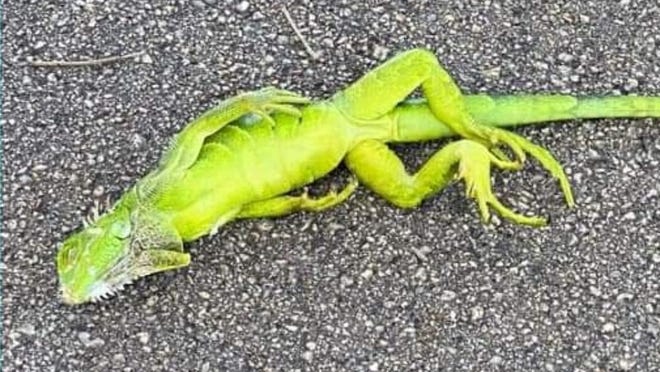- Conservancy biologists in Florida caught an almost 18-foot-long, 215-pound Burmese python.
- The invasive snake is the biggest Burmese python ever found in state’s Everglades.
- The python was caught in December, but wasn’t made public until this week – when National Geographic published an exclusive story about the program.
FORT MYERS, Fla. — Conservancy biologists caught the biggest Burmese python ever found in Florida’s Everglades: an almost 18-foot-long, 215-pound female loaded with 122 eggs.
The record-breaking invasive snake was deep in the scrub of Picayune Strand State Forest in Florida’s Collier County, where a radio-equipped male “scout” snake named Dion led researchers to her.
Though scientists prefer not to make guesses, wildlife biologist Ian Bartoszek says there’s a good chance the massive matriarch might well be one of the original pet snakes released into the wild decades ago.
In recent years, pythons have gone off like a bomb in the Everglades, devastating populations of native mammals including rabbits, opossum and white-tailed deer – creatures that should feed the endangered Florida panthers instead of introduced Asian reptiles.
So successfully have the pythons adapted to their new niche, says Bartoszek, environmental science project manager for the Conservancy, that, “We may have more Burmese pythons in south Florida than in southeast Asia,” where numbers are dwindling as habitat disappears.
Invasive pythons slither north in Everglades:May mean snake ‘population is expanding’ in Florida
Removing them will help the whole system return to health, says Conservancy of Southwest Florida CEO Rob Moher. “We’re spending $16 billion to restore the Everglades – it’s one of the most ambitious restoration projects in the history of the world and it’s on our doorstep here (and) you have this” he says, gesturing to the gigantic python spread on a lab table for a group of journalists, “in the middle of the western Everglades.”
“So, is there a future where the western Everglades is silent? Imagine going out and there’s no wildlife, no bird life because this apex predator is just devouring what is out there.”
The snake on the table had been dead more than six months. Though she was bagged last December, National Geographic was writing an exclusive story about the program that wasn’t published until Tuesday, so scientists “weren’t allowed to share anything until it released,” said Conservancy spokeswoman Katy Hennig.
The python was euthanized shortly after capture, though Hennig would not say how – only that the technique was humane and veterinarian-approved.
Her carcass will be used for science, with tissue samples going to various institutions – “Sky’s the limit on what we can do with the genetics,” Bartoszek said – and her skeleton likely used as a teaching tool.
Video:Biologists capture ‘antagonistic’ interaction between bobcat and python in Florida
Something this size had to eat a lot of other animals to get that way, says Bartoszek. “These are big-game hunters … The last meal this animal had was a white-tailed deer – this is panther food.”
Over the past 10 years, the Conservancy’s team has removed 26,000 pounds of pythons – some 1,000 snakes – from 100 square miles. “But how many more are there?” Bartoszek asks. “Is that 10%? Is that one percent? We don’t know (but) we’re actively pulling them out and working with research partners to see if we can better get at that metric and move the science forward.”
One innovative technique the team has developed: double-agent male pythons. Equipped with radio trackers, these bachelors go in search of females, and when they find one, the scientists swoop in.
‘Scout’ snakes:Biologists are using snakes with transmitters to catch invasive pythons in the Everglades
This critter didn’t give in without a fight. Biologist Ian Easterling recalls trying to hang on to her brick-sized head as she writhed, clubbing him in the eye with her tail. “It felt like a fist,” said Easterling.
Once subdued and weighed, the team realized they had a new champion. The previous record weighed in at 185 pounds.
Yet for all the ecosystem havoc Burmese pythons wreak, Bartoszek respects them. “It’s a beautiful animal; they’re very good at what they do.”
What’s everyone talking about?:Sign up for our trending newsletter to get the latest news of the day
And he fears these snakes may not be the last invasive challenge the glades has to face.
”We have a vibrant pet trade (and) many ports of entry (and) a tropical and subtropical climate … a perfect storm,” Bartoszek says. “The question is now: What’s next?”


